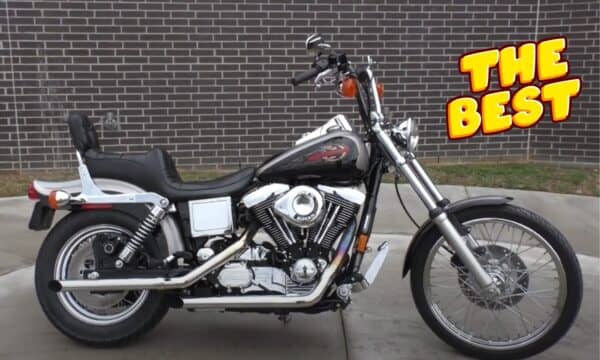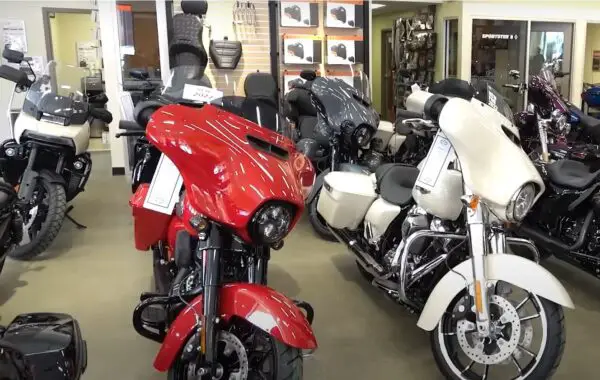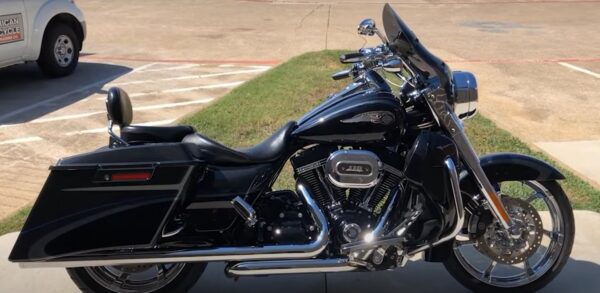
If you are stuck choosing the one from Wide Glide or Super Glide, don’t worry because it is the most common problem for motorbikes lovers.
But we have worked hard and tested both bikes to check the differences between both bikes. We have also considered the users’ reviews to pick the best from both bikes.
As these two titans of the motorcycle world go head-to-head, we’re about to dive deep into a thrilling comparison that promises to keep every enthusiast on the edge of their seat.
Let’s dive into:
Wide Glide Vs Super Glide
It isn’t easy to choose the best bike from these two most popular models, and you will be able to make a solid decision at the end of this article.
Wide Glide (Overview)
The Harley-Davidson Wide Glide is a motorcycle that has carved its niche in the annals of biking history. Let’s delve into a comprehensive review of this iconic bike, touching on its features and tracing its storied past.
History
The Wide Glide made its debut in the Harley-Davidson lineup in 1980. It was introduced as a custom bike that drew inspiration from the chopper designs of the 1960s and 1970s. Over the decades, the Wide Glide has undergone numerous refinements. Still, it has always retained its distinct chopper-inspired look, characterized by its raked-out fork, wide front tire, and narrow profile.
Design
The Wide Glide is known for its distinctive design and stance, which sets it apart from other Harley models. Let’s take a look at the structure of Wide Glide.
One of the most distinguishing features of the Wide Glide is its raked-out front end. This means the forks are set at a more obtuse angle than the frame, giving the bike a longer and more “laid-back” appearance.
The Wide Glide features a wider front tire compared to other models. This wider tire complements the raked front end and contributes to the bike’s unique stance and road presence.
Many Wide Glides come with “ape hanger” handlebars that rise above the rider’s shoulders. These handlebars give the rider a distinctive riding posture and are iconic to the chopper and custom bike scene.
The Wide Glide is often associated with custom looks, featuring unique paint jobs, chrome detailing, and aftermarket modifications. Owners often personalize their Wide Glides to reflect their individual tastes.
Engine
The Wide Glide is typically powered by Harley-Davidson’s air-cooled Twin Cam engine. Over the years, this engine’s specific displacement and design have evolved.
Depending on the year and specific model, the Wide Glide has been equipped with various displacements, including the 96 cubic inches (1,584 cc) and the 103 cubic inch (1,690 cc) versions of the Twin Cam engine.
The Twin Cam engine is a V-twin with two cylinders arranged in a V shape. This design is iconic for Harley-Davidson and is known for its distinctive rumble and torque-rich performance.
Modern versions of the Wide Glide come with electronic fuel injection (EFI), which offers more precise fuel delivery and improved reliability compared to older carbureted systems.
While Harley-Davidson Wide Glide are not typically known for high-revving, sporty performance, they are renowned for their low-end torque and smooth power delivery. This makes them ideal for relaxed cruising and long rides.
It’s worth noting that before the Twin Cam engine, the Wide Glide was powered by the Evolution engine in its earlier years. The Evolution engine, also known as the Evo, was another iconic Harley-Davidson engine in production from 1984 to 1999.
Ride and Handling
The Wide Glide features a raked-out front end and a broad fork, which gives it its name. This design choice affects the bike’s handling, especially at low speeds. The bike’s suspension is softer, typical for cruisers, ensuring a comfortable ride over most road conditions.
The Wide Glide has a long wheelbase, which provides stability at highway speeds. However, this also means the bike is less agile in tight corners than motorcycles with shorter wheelbases. The Wide Glide typically comes with wider front tires. While this adds to the bike’s aggressive stance and appearance, wider tires can make the steering feel heavier, especially at low speeds.
The torque-rich V-twin engine provides plenty of power for cruising and overtaking. The smooth transmission allows for easy gear changes, contributing to the overall riding experience.
Due to its cruiser design, the Wide Glide tends to absorb most road imperfections, offering a plush ride. However, this also means that the rider might get less feedback from the road compared to sportier motorcycles.
Customization
One of the hallmarks of the Wide Glide is its adaptability to customization. Owners can make their bikes unique, from custom paint jobs to aftermarket parts.
Comfort
The low-slung seat, combined with the laid-back riding position, ensures that riders can easily cover long distances. The saddle is designed to offer optimum support, and the foot controls are positioned for relaxed cruising.
Technology
Over the years, Harley-Davidson has infused the Wide Glide with modern tech features, such as LED lighting, keyless ignition, and an advanced security system, ensuring the bike remains contemporary.
Super Glide (Overview)
The Harley-Davidson Super Glide, part of Harley’s storied Dyna lineup, is often considered the original factory custom motorcycle. Combining the sporty elements of the Harley-Davidson XL series and the more significant, heftier frames of the FL series, the Super Glide amalgamates the best parts of its family lineage.
Design
The Super Glide adopts a low-slung stance typical of many cruisers. Still, it maintains an athletic profile that suggests highway comfort and city maneuverability.
The frame is robust and follows the clean lines that Harley-Davidson is known for, avoiding excessive embellishments.
One of the most iconic features is its teardrop-shaped fuel tank. This design complements the bike’s overall silhouette and carries a nostalgic aura reminiscent of earlier Harley models.
The front forks are slightly raked out, giving it that relaxed cruiser appearance. The Super Glide often features a two-up seat, ensuring both rider and passenger comfort. Its streamlined design ensures it doesn’t interrupt the bike’s flowing lines.
Minimalistic design, the fenders cover just enough of the wheels to prevent splashes while showcasing as many spoked or alloy wheels as possible. This minimalism gives the Super Glide a slightly raw and stripped-down look.
Mid-mounted controls are a staple of the Super Glide. They allow for a more engaged riding posture than forward controls, which can be found on more laid-back cruiser models.
Engine
With its distinctive rumble, the V-twin engine has long been symbolic of the Harley-Davidson brand. This design offers aesthetics and a unique performance characteristic that has appealed to riders for generations. The two cylinders are arranged in a “V” formation, where the name comes from.
The Super Glide was first introduced in 1971, during the era of the Shovelhead engine. It was a hybrid of the large-frame FL series and the smaller sportier XL series, offering a new dynamic to the Harley lineup. The Evolution engine, often called the “Evo,” succeeded the Shovelhead. It featured aluminum heads and cylinders, which improved cooling and reduced weight. This engine was more reliable than its predecessors and played a significant role in the reputation of Harley-Davidson motorcycles.
The Super Glide transitioned to the Twin Cam engine in the late 1990s. This engine was introduced with improvements in power and reliability. The Twin Cam was named for its two camshafts. It was available in 88 cubic inches (1,450 cc) and later in 96 cubic inches (1,584 cc), among other displacements in specific models.
The Milwaukee-Eight is the most recent big twin engine from Harley-Davidson, succeeding the Twin Cam. This engine offers smoother performance, reduced vibration, improved cooling (in air-cooled and liquid-cooled versions), and increased power. “Milwaukee-Eight” refers to its origin in Milwaukee, Wisconsin, and its eight valves (four per cylinder).
Riding and Handling
The Super Glide is designed for laid-back, relaxed rides. The rider’s posture is generally upright, with feet forward. The handlebars are comfortably reachable, and the saddle is wide and cushioned. This ergonomic design makes long highway cruises a joy.
Like most Harley-Davidsons, Super Glides are known for their low center of gravity. This feature ensures better handling, especially during slow-speed maneuvers like parking or U-turns. Super Glides are not lightweight bikes. Their solid build and weight contribute to stability, especially at high speeds or crosswinds. This heft might be challenging for new riders, but it is a highway boon.
Historically, Harley-Davidsons weren’t renowned for plush suspensions. However, with the advancements in technology and design, the Super Glide’s suspension has seen significant improvements.
Modern iterations provide a smoother ride, absorbing road imperfections decently. Yet, it’s essential to note that it’s still a cruiser and won’t handle road undulations like a sport-tourer or an adventure bike.
With advancements in technology, Super Glides have benefited from improved braking systems. Many models come equipped with anti-lock brakes (ABS), ensuring safer and more efficient stopping in various conditions.
Technology
Over the years, the Super Glide has seen numerous technological advancements that have kept it relevant in a rapidly evolving motorcycle industry.
The Super Glide, especially in its recent iterations, was often equipped with the Milwaukee-Eight engine, which features four valves per cylinder, improved cooling, and enhanced fuel injection. This translates to a smoother, more powerful ride.
The earlier models of Super Glide were known for their Twin Cam engines, offering solid performance and that classic Harley V-twin rumble.
The Super Glide’s Dyna chassis is designed for an optimal balance of comfort and handling. This chassis design provides a rigid backbone and allows for a low-slung profile.
Some models came with an adjustable rear suspension system, enabling riders to tweak the suspension according to their weight and riding preferences.
Modern iterations of the Super Glide have adopted LED technology for headlights, tail lights, and turn signals. LEDs offer better visibility, longer life, and a contemporary aesthetic.
Some newer models come equipped with keyless ignition, allowing for a more convenient start-up process and increased security.
Offering smooth shifting and a broad torque curve, Six-Speed Cruise Drive Transmission ensures a comfortable ride, whether cruising city streets or open highways.
Differences Between Wide Glide and Super Glide
Both the Super Glide and the Wide Glide are motorcycles from the iconic American brand Harley-Davidson. They belong to the Dyna family of motorcycles offered by Harley-Davidson until the 2018 model year when it was discontinued and merged into the Softail line.
Engine
Harley-Davidson Wide Glide (FXDWG) and Super Glide (FXD)
Both the Wide Glide and the Super Glide typically use a V-Twin engine, known as the Twin Cam 103, or earlier models with the Twin Cam 96.
Displacement
- Twin Cam 96: 1584 cc
- Twin Cam 103: 1690 cc
Bore x Stroke
- Twin Cam 96: 95.3 mm x 111.1 mm
- Twin Cam 103: 98.4 mm x 111.1 mm
It varies depending on the year, but typically around 9.6:1 for both models.
Both used Electronic Sequential Port Fuel Injection (ESPFI) and Air-cooled engine. Both bikes typically come with chrome, staggered shorty exhausts with dual mufflers.
While the basic engine architecture and specs might be the same or similar between the Wide Glide and the Super Glide, the bike’s weight, tuning, and other factors can influence the overall performance.
The V-Twin engine is renowned for its iconic rumble and torque-rich performance, a hallmark of Harley-Davidson motorcycles.
Given their similar architecture, both engines will have comparable maintenance schedules and needs. Always refer to the owner’s manual for specific maintenance requirements.
Front End & Wheelbase
As the name implies, the Wide Glide features a wider front end. The forks are set further apart when compared to the Super Glide. This gives the Wide Glide a more stretched-out and chopper-like appearance.
The Super Glide has a more standard, narrower front end. It doesn’t have wide-set forks compared to Wide Glide, which gives it a more compact and traditional appearance.
Wheel Base
The Wide Glide generally has a longer wheelbase. A longer wheelbase can result in more stability at high speeds. Still, it makes the bike less agile in tight corners when compared to motorcycles with a shorter wheelbase.
The Super Glide, on the other hand, has a slightly shorter wheelbase compared to the Wide Glide. This makes it more maneuverable in certain conditions.
Note: These are general comparisons, and it’s always a good idea to refer to the specific year’s specifications and manuals to get the most accurate information, as manufacturers make changes from year to year.
Styling
Often a more fundamental and straightforward design in Super Glide. However, various models and iterations have introduced different styling cues over the years.
Wide Glide features a more custom look reminiscent of the classic chopper style. It often comes with more distinct paint schemes and design elements.
Seat & Riding Position
Super Glide generally offers a more neutral seating position than Wide Glide. Riders might experience a more laid-back place with forward controls and extended reach to the handlebars in the Wide Glide chopper-inspired design.
Conclusion
The Wide Glide and Super Glide are iconic models in the motorcycling world, each with distinct characteristics and charm. When deciding between the two, the choice largely depends on your preferences and intended use.
The Wide Glide is celebrated for its raked-out front end and broader front wheel. Its unique design gives it a distinctive appearance, making it the preferred choice for riders who value a bolder aesthetic and may want to customize their ride further. It provides a more laid-back riding experience and is typically suited for cruising longer distances leisurely.
On the other hand, the Super Glide offers a more versatile and balanced approach. It is renowned for its straightforward, stripped-down style. With its neutral stance and agility, the Super Glide provides a dynamic riding experience that adapts well to city commutes and open roads. Its simplicity makes it a great starting point for custom projects as well.
If you are leaning towards a bike with a robust, commanding presence and classic cruiser, feel, the Wide Glide might be your best pick. However, you’re in the market for a more versatile machine that’s both efficient in the city and comfortable on the highway. In that case, the Super Glide should be on your list.
Sources
2017 Harley Davidson Wide Glide Review
You may also love to read!
Harley Mid Controls Vs Forward Controls

Ahtsham Younas is a passionate blogger and content writer. He loves to ride motorcycles and learn the mechanical process behind the motorcycles.
He has been writing articles in the motorcycle industry since 2019 and has learned many things about motorbike niches.


